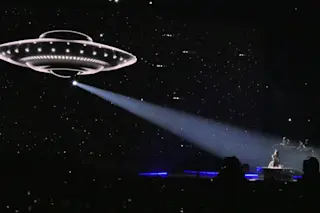Relaxing on an idyllic beach on Grand Cayman Island in the Caribbean, Anthony Aguirre vividly describes the worst natural disaster he can imagine. It is, in fact, probably the worst natural disaster that anyone could imagine. An asteroid impact would be small potatoes compared with this kind of event: a catastrophic encounter with an entire other universe.
As an alien cosmos came crashing into ours, its outer boundary would look like a wall racing forward at nearly the speed of light; behind that wall would lie a set of physical laws totally different from ours that would wreck everything they touched in our universe. “If we could see things in ultraslow motion, we’d see a big mirror in the sky rushing toward us because light would be reflected by the wall,” says Aguirre, a youthful physicist at the University of California at Santa Cruz. “After that we wouldn’t see anything—because ...













